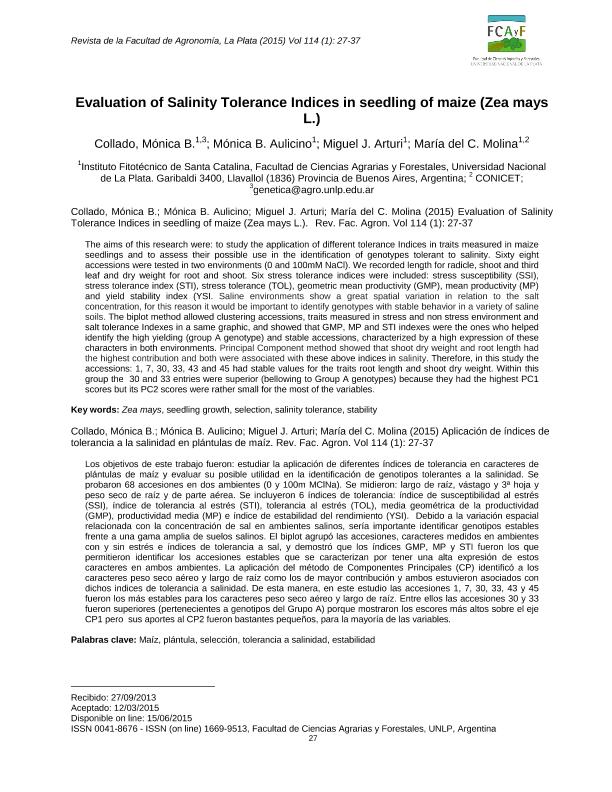Mostrar el registro sencillo del ítem
dc.contributor.author
Collado, Mónica B.
dc.contributor.author
Aulicino, Mónica Beatriz

dc.contributor.author
Arturi, Miguel Jacinto

dc.contributor.author
Molina, María del Carmen

dc.date.available
2018-08-01T17:40:59Z
dc.date.issued
2015-05
dc.identifier.citation
Collado, Mónica B.; Aulicino, Mónica Beatriz; Arturi, Miguel Jacinto; Molina, María del Carmen; Evaluation of Salinity Tolerance Indices in seedling of maize (Zea mays L.); Universidad Nacional de La Plata. Facultad de Agronomía; Revista de la Facultad de Agronomía; 114; 1; 5-2015; 27-37
dc.identifier.issn
0041-8676
dc.identifier.uri
http://hdl.handle.net/11336/53760
dc.description.abstract
Los objetivos de este trabajo fueron: estudiar la aplicación de diferentes índices de tolerancia en caracteres de plántulas de maíz y evaluar su posible utilidad en la identificación de genotipos tolerantes a la salinidad. Se probaron 68 accesiones en dos ambientes (0 y 100m MClNa). Se midieron: largo de raíz, vástago y 3ª hoja y peso seco de raíz y de parte aérea. Se incluyeron 6 índices de tolerancia: índice de susceptibilidad al estrés (SSI), índice de tolerancia al estrés (STI), tolerancia al estrés (TOL), media geométrica de la productividad (GMP), productividad media (MP) e índice de estabilidad del rendimiento (YSI). Debido a la variación espacial relacionada con la concentración de sal en ambientes salinos, sería importante identificar genotipos estables frente a una gama amplia de suelos salinos. El biplot agrupó las accesiones, caracteres medidos en ambientes con y sin estrés e índices de tolerancia a sal, y demostró que los índices GMP, MP y STI fueron los que permitieron identificar los accesiones estables que se caracterizan por tener una alta expresión de estos caracteres en ambos ambientes. La aplicación del método de Componentes Principales (CP) identificó a los caracteres peso seco aéreo y largo de raíz como los de mayor contribución y ambos estuvieron asociados con dichos indices de tolerancia a salinidad. De esta manera, en este estudio las accesiones 1, 7, 30, 33, 43 y 45 fueron los más estables para los caracteres peso seco aéreo y largo de raíz. Entre ellos las accesiones 30 y 33 fueron superiores (pertenecientes a genotipos del Grupo A) porque mostraron los escores más altos sobre el eje CP1 pero sus aportes al CP2 fueron bastantes pequeños, para la mayoría de las variables.
dc.description.abstract
The aims of this research were: to study the application of different tolerance Indices in traits measured in maize seedlings and to assess their possible use in the identification of genotypes tolerant to salinity. Sixty eight accessions were tested in two environments (0 and 100mM NaCl). We recorded length for radicle, shoot and third leaf and dry weight for root and shoot. Six stress tolerance indices were included: stress susceptibility (SSI), stress tolerance index (STI), stress tolerance (TOL), geometric mean productivity (GMP), mean productivity (MP) and yield stability index (YSI. Saline environments show a great spatial variation in relation to the salt concentration, for this reason it would be important to identify genotypes with stable behavior in a variety of saline soils. The biplot method allowed clustering accessions, traits measured in stress and non stress environment and salt tolerance Indexes in a same graphic, and showed that GMP, MP and STI indexes were the ones who helped identify the high yielding (group A genotype) and stable accessions, characterized by a high expression of these characters in both environments. Principal Component method showed that shoot dry weight and root length had the highest contribution and both were associated with these above indices in salinity. Therefore, in this study the accessions: 1, 7, 30, 33, 43 and 45 had stable values for the traits root length and shoot dry weight. Within this group the 30 and 33 entries were superior (bellowing to Group A genotypes) because they had the highest PC1 scores but its PC2 scores were rather small for the most of the variables.
dc.format
application/pdf
dc.language.iso
spa
dc.publisher
Universidad Nacional de La Plata. Facultad de Agronomía
dc.rights
info:eu-repo/semantics/openAccess
dc.rights.uri
https://creativecommons.org/licenses/by-nc-sa/2.5/ar/
dc.subject
Zea Mays
dc.subject
Seedling Growth
dc.subject
Selection
dc.subject
Salinity Tolerance
dc.subject
Stability
dc.subject.classification
Agricultura

dc.subject.classification
Agricultura, Silvicultura y Pesca

dc.subject.classification
CIENCIAS AGRÍCOLAS

dc.title
Evaluation of Salinity Tolerance Indices in seedling of maize (Zea mays L.)
dc.title
Aplicación de índices de tolerancia a la salinidad en plántulas de maíz
dc.type
info:eu-repo/semantics/article
dc.type
info:ar-repo/semantics/artículo
dc.type
info:eu-repo/semantics/publishedVersion
dc.date.updated
2018-08-01T14:22:13Z
dc.journal.volume
114
dc.journal.number
1
dc.journal.pagination
27-37
dc.journal.pais
Argentina

dc.journal.ciudad
La Plata
dc.description.fil
Fil: Collado, Mónica B.. Universidad Nacional de La Plata. Facultad de Ciencias Agrarias y Forestales. Instituto Fitotécnico de "Santa Catalina"; Argentina
dc.description.fil
Fil: Aulicino, Mónica Beatriz. Universidad Nacional de La Plata. Facultad de Ciencias Agrarias y Forestales. Instituto Fitotécnico de "Santa Catalina"; Argentina. Consejo Nacional de Investigaciones Científicas y Técnicas; Argentina
dc.description.fil
Fil: Arturi, Miguel Jacinto. Universidad Nacional de La Plata. Facultad de Ciencias Agrarias y Forestales. Instituto Fitotécnico de "Santa Catalina"; Argentina
dc.description.fil
Fil: Molina, María del Carmen. Universidad Nacional de La Plata. Facultad de Ciencias Agrarias y Forestales. Instituto Fitotécnico de "Santa Catalina"; Argentina. Consejo Nacional de Investigaciones Científicas y Técnicas; Argentina
dc.journal.title
Revista de la Facultad de Agronomía
dc.relation.alternativeid
info:eu-repo/semantics/altIdentifier/url/http://revista.agro.unlp.edu.ar/index.php/revagro/article/view/412
Archivos asociados
